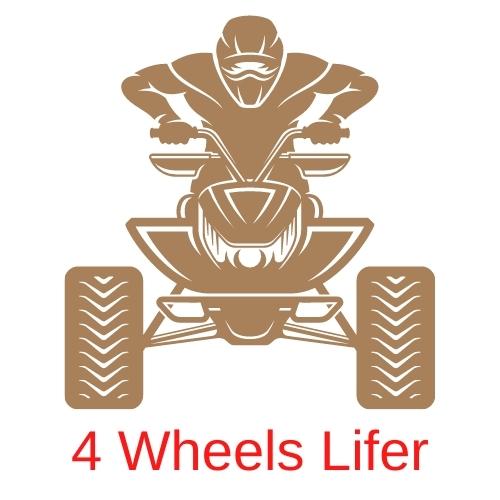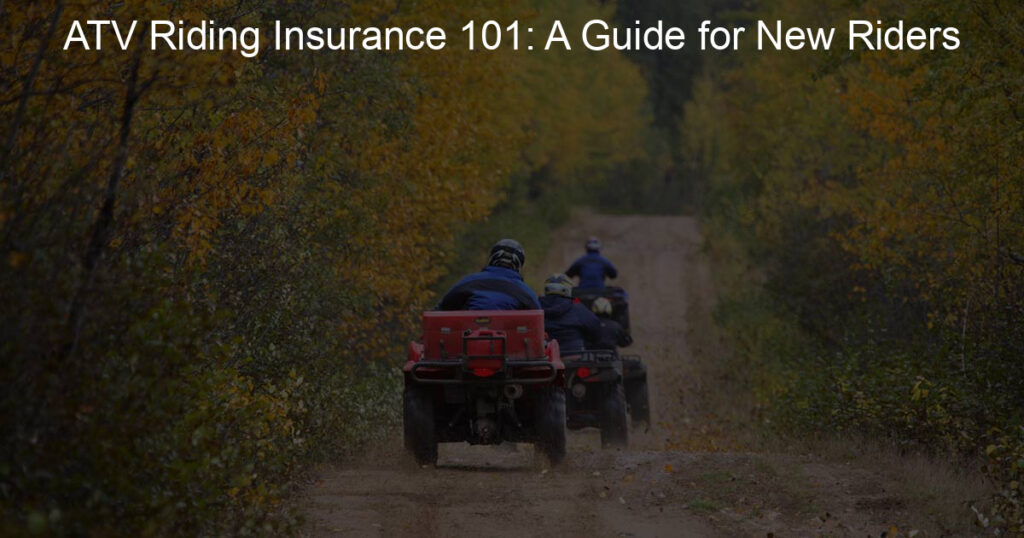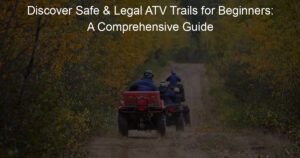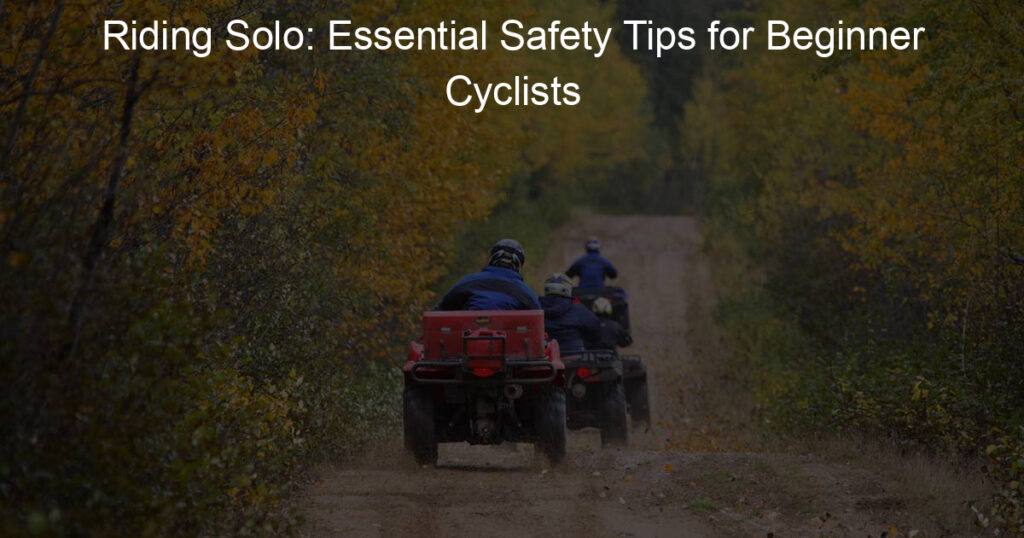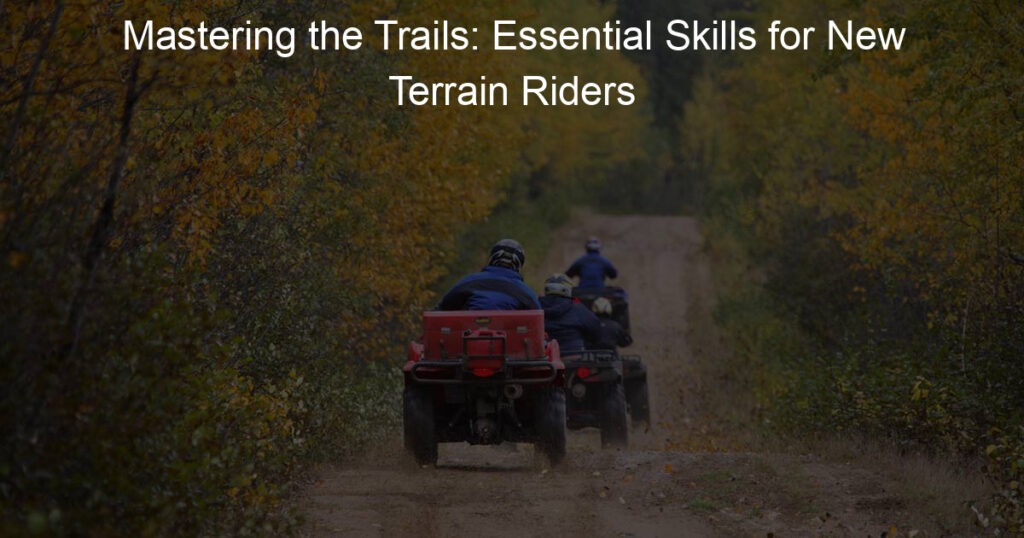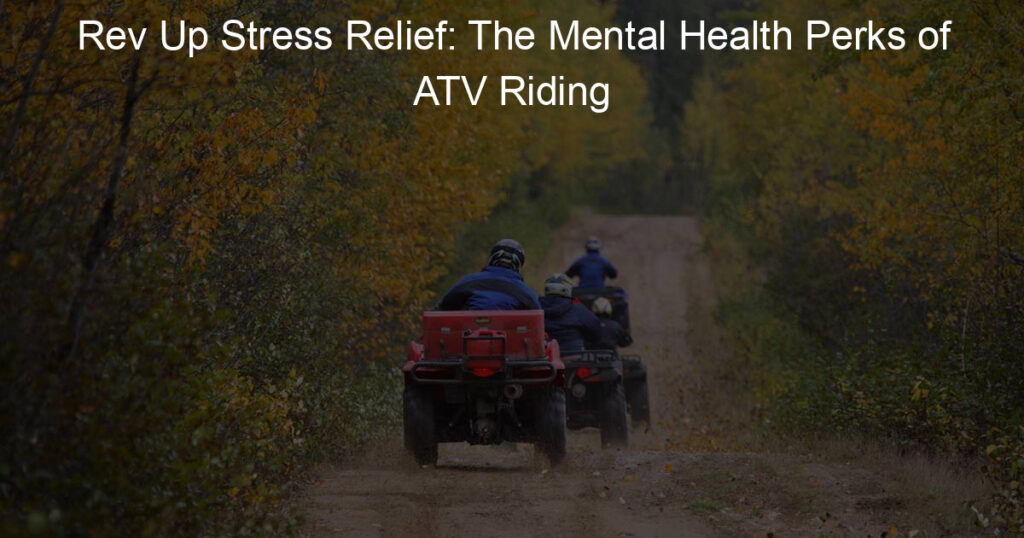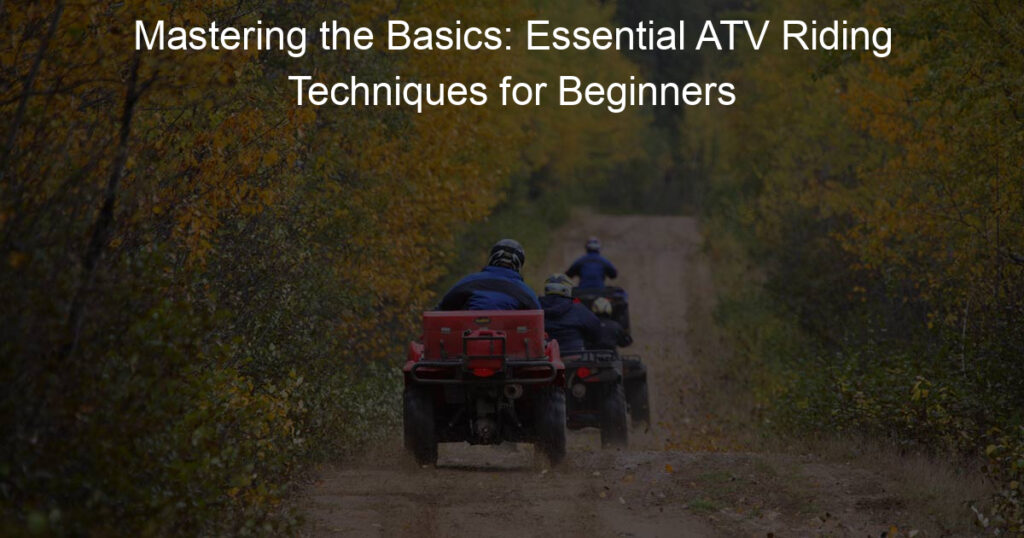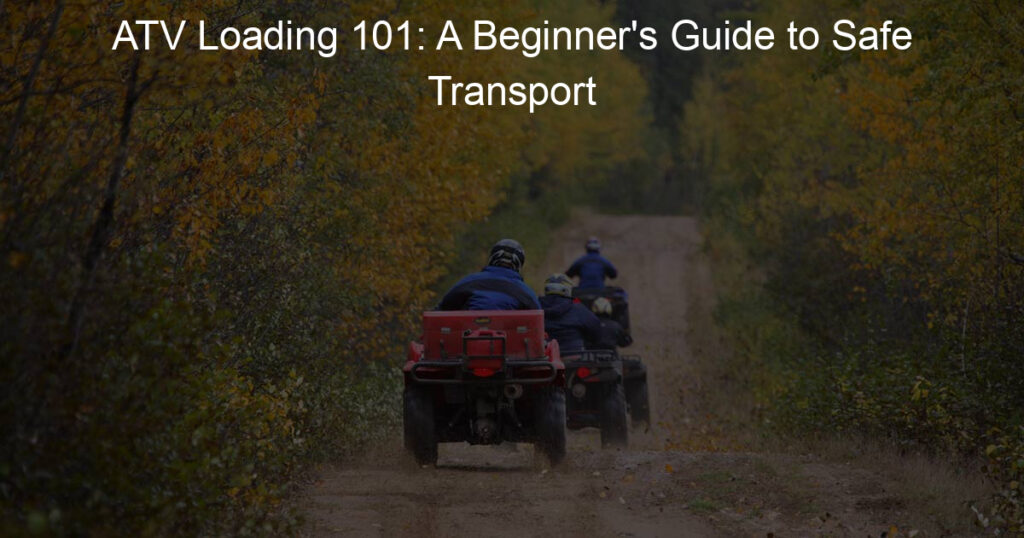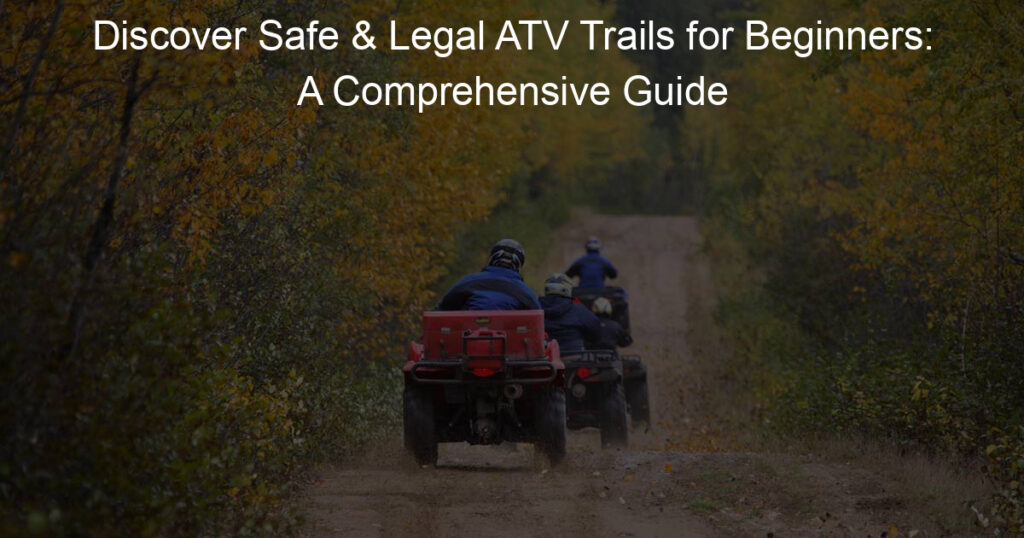
Introduction to ATV Riding Insurance for New Riders
Welcome to the exciting world of All-Terrain Vehicle (ATV) riding! As a new rider, you might be eager to hit the trails and explore the great outdoors. But before you do, it’s important to understand the role of ATV riding insurance. This guide will help you understand its importance and why it’s crucial for new riders like you.
- Understanding the Importance of ATV Riding Insurance
- Why New Riders Need ATV Insurance
ATV riding insurance is a type of coverage that protects you, your vehicle, and others in case of an accident. It’s not just about repairing or replacing your ATV, but also about covering medical bills and legal costs that can arise from an accident. Without insurance, these costs can quickly add up and become a financial burden.
Just like car insurance, ATV insurance is designed to help you manage risks. It’s a safety net that gives you peace of mind, knowing that you’re protected if something goes wrong. It’s not just about financial protection, but also about being a responsible rider.
If you’re a new rider, you might think that ATV insurance is not necessary. After all, you’re just starting out and you might not be riding as often or as aggressively as more experienced riders. But the truth is, new riders are often at a higher risk of accidents. This is because they’re still learning how to handle the vehicle and navigate different terrains.
ATV insurance is especially important for new riders because it can cover the costs of accidents, including medical bills and property damage. It can also cover the costs of theft or damage to your ATV. This means that if your ATV is stolen or damaged, you won’t have to pay out of pocket to replace or repair it.
Remember, ATV riding is a thrilling adventure, but it’s also a responsibility. With the right insurance, you can enjoy the ride without worrying about the financial risks.
Understanding ATV Insurance Options
When it comes to ATV insurance, understanding your options is crucial. Different types of policies offer varying levels of protection. Let’s delve into the types of ATV insurance policies available.
Types of ATV Insurance Policies
There are four main types of ATV insurance policies. Each one offers a different level of protection and covers different scenarios. It’s important to understand what each policy covers to make an informed decision.
- Liability Coverage
- Collision Coverage
- Comprehensive Coverage
- Uninsured/Underinsured Motorist Coverage
This type of insurance covers the costs if you’re at fault in an accident. It can help pay for the other person’s medical bills or property damage. However, it doesn’t cover your own injuries or damages to your ATV.
Collision coverage helps pay for repairs or replacement of your ATV if it’s damaged in an accident, regardless of who’s at fault. This can be particularly useful if your ATV is expensive or new.
Comprehensive coverage goes beyond collision coverage. It covers damages to your ATV caused by events other than a collision, such as theft, fire, or natural disasters.
This type of coverage protects you if you’re in an accident with someone who doesn’t have insurance or doesn’t have enough insurance to cover the costs. It can help pay for your medical bills and damages to your ATV.
Understanding these different types of ATV insurance policies can help you make an informed decision about the best coverage for your needs. Remember, the right insurance policy can provide peace of mind and financial protection in the event of an accident.
Choosing the Right ATV Insurance Policy
Choosing the right ATV insurance policy can feel like a daunting task, but it doesn’t have to be. By understanding the key factors to consider and knowing how to compare different policies, you can make an informed decision that suits your needs and budget.
- Factors to consider when choosing an ATV insurance policy
- Your ATV’s value: The higher the value of your ATV, the more coverage you might need to protect your investment.
- Usage: How and where you use your ATV can greatly influence the type of insurance you need. For instance, if you use your ATV for work, you might need a different type of coverage than if you use it for recreational purposes.
- Risk factors: Factors such as your driving record, age, and location can affect the cost of your policy.
- Budget: Determine how much you can afford to pay for insurance, keeping in mind that cheaper isn’t always better. You want to ensure you have adequate coverage in case of an accident.
- How to compare different ATV insurance policies
- Compare coverage types: Not all ATV insurance policies offer the same types of coverage. Make sure to compare the details of each policy to ensure you’re getting the coverage you need.
- Compare prices: While price shouldn’t be the only factor you consider, it’s important to compare prices to ensure you’re getting a fair deal.
- Read reviews: Reviews from other ATV owners can give you insight into a company’s customer service and claims process.
- Ask for quotes: Most insurance companies offer free quotes. Use these to compare prices and coverage options from different companies.
When choosing an ATV insurance policy, several factors should be taken into account:
Comparing different ATV insurance policies can help you find the best coverage at the best price. Here’s how:
In conclusion, choosing the right ATV insurance policy involves considering various factors and comparing different policies. By doing so, you can find a policy that provides the coverage you need at a price you can afford.
ATV Insurance Requirements
When it comes to ATV riding, insurance is a critical aspect that every rider must consider. It’s not just about protecting your vehicle; it’s about ensuring your safety and financial security. Let’s delve into the legal requirements for ATV insurance.
Legal Requirements for ATV Insurance
The legal requirements for ATV insurance can vary from state to state. However, there are two primary aspects that you need to understand: state-specific ATV insurance requirements and the penalties for not having ATV insurance.
- State-specific ATV insurance requirements
- Understanding the penalties for not having ATV insurance
Each state has its own rules and regulations when it comes to ATV insurance. Some states may require you to have liability insurance, which covers the costs if you cause an accident. Others may require comprehensive coverage, which includes damage from things like theft or natural disasters. It’s essential to check with your state’s Department of Motor Vehicles or an insurance professional to understand what is required in your area.
Not having ATV insurance can lead to serious consequences. If you’re caught riding without insurance, you could face fines, suspension of your driver’s license, or even jail time. Additionally, if you’re involved in an accident without insurance, you could be held personally responsible for any damages or injuries. This could lead to significant financial hardship. Therefore, it’s not worth the risk to ride without proper ATV insurance.
Understanding the legal requirements for ATV insurance is the first step in protecting yourself and your ATV. Remember, riding an ATV should be fun and exciting, not a source of financial stress. So, make sure you’re covered before you hit the trails.
Off-road Vehicle Insurance vs. ATV Insurance
When it comes to outdoor adventures, both off-road vehicles and all-terrain vehicles (ATVs) offer a thrilling experience. However, before you hit the trails, it’s important to understand the differences between off-road vehicle insurance and ATV insurance, and which one is right for you.
- Differences between off-road vehicle insurance and ATV insurance
- Which one is right for you?
Off-road vehicle insurance and ATV insurance may seem similar, but they cater to different types of vehicles and cover different risks. Off-road vehicle insurance typically covers 4×4 vehicles like Jeeps and trucks that can be driven both on and off public roads. It often includes collision and comprehensive coverage, liability insurance, and may also cover custom parts and equipment.
On the other hand, ATV insurance is specifically designed for all-terrain vehicles, which are primarily used off public roads. ATV insurance usually covers damages from collision and other risks like theft or fire, liability for bodily injury or property damage, and even some custom parts and equipment.
Choosing between off-road vehicle insurance and ATV insurance depends on the type of vehicle you own and how you use it. If you have a 4×4 vehicle that you drive on public roads as well as off-road trails, off-road vehicle insurance would be a better fit. However, if you own an ATV that you use exclusively for off-road adventures, ATV insurance would be the right choice.
Remember, the goal is to choose an insurance policy that offers the best protection for your vehicle and fits your specific needs. Always review the policy details carefully and consult with an insurance professional if you have any doubts.
In conclusion, both off-road vehicle insurance and ATV insurance offer valuable protection for your outdoor adventures. By understanding the differences and evaluating your needs, you can choose the right insurance for you.
Learn ATV Riding: A Guide for Beginners
If you’re a beginner looking to learn ATV riding, this guide is for you. We’ll cover everything from what to expect from ATV riding lessons to how these lessons can lower your insurance premiums. So, let’s get started!
ATV Riding Lessons
ATV riding lessons are a crucial first step for any beginner. They not only equip you with the necessary skills but also ensure your safety while riding. Let’s delve into what you can expect from these lessons and how they can benefit you.
- What to expect from ATV riding lessons
- How ATV riding lessons can lower your insurance premiums
ATV riding lessons typically start with the basics. You’ll learn about the different parts of an ATV, how to start and stop the vehicle, and how to maneuver it. As you progress, you’ll be taught more advanced techniques like how to navigate different terrains and how to handle the ATV in various weather conditions. The lessons are usually hands-on, meaning you’ll get plenty of practice riding an ATV under the supervision of a trained instructor.
Did you know that taking ATV riding lessons can actually lower your insurance premiums? Insurance companies often offer discounts to riders who have completed a certified ATV riding course. The reason is simple: trained riders are less likely to be involved in accidents, which means they pose a lower risk to the insurance company. So, by taking ATV riding lessons, you’re not only improving your riding skills but also saving money on insurance!
In conclusion, ATV riding lessons are an essential part of learning to ride an ATV. They provide you with the knowledge and skills you need to ride safely and confidently. Plus, they can even help you save money on your ATV insurance. So, if you’re a beginner, don’t hesitate to sign up for ATV riding lessons!
ATV Safety Tips for New Riders
When it comes to ATV riding, safety should always be your top priority. Here are some essential tips for new riders to ensure a safe and enjoyable experience.
- Essential safety gear for ATV riders
- Helmet: A helmet is the most important piece of safety gear. It protects your head from injuries in case of an accident. Make sure it fits well and is certified by the Department of Transportation.
- Goggles: Goggles protect your eyes from dust, debris, and wind. They also provide clear vision, which is essential for safe riding.
- Gloves: Gloves protect your hands from blisters and cuts. They also provide a better grip on the handlebars.
- Boots: ATV riding boots protect your feet and ankles from injuries. They also provide better control over the foot pedals.
- Protective clothing: Long sleeves, long pants, and a jacket made of durable material can protect your skin from scratches and burns.
- Safe riding practices to avoid accidents
- Stay on designated trails: Riding on designated trails reduces the risk of encountering unexpected obstacles or dangerous terrains.
- Don’t ride alone: Always ride with a buddy. If something goes wrong, you’ll have someone to help you.
- Don’t speed: Speeding increases the risk of losing control of your ATV. Always ride at a speed that allows you to react quickly to any situation.
- Take a safety course: A safety course can teach you the basics of ATV riding and how to respond in emergency situations.
Before you hop on your ATV, it’s crucial to gear up properly. Here’s a list of essential safety gear every ATV rider should have:
Proper riding techniques can significantly reduce the risk of accidents. Here are some safe riding practices:
Remember, safety is paramount when it comes to ATV riding. Always wear your safety gear and follow safe riding practices to ensure a fun and safe ride.
Case Studies: ATV Insurance Claims
Let’s take a look at two real-life situations to understand the importance of ATV insurance. These case studies will help you understand the potential financial implications of ATV accidents, both with and without insurance.
-
Case Study 1: ATV Accident Without Insurance
John, an experienced ATV rider, decided to go for a ride on a sunny afternoon. Unfortunately, he lost control and collided with a tree. John was okay, but his ATV was severely damaged.
Without ATV insurance, John had to pay for all the repair costs out of his pocket. The total came to a whopping $3,000. This incident left John with a significant financial burden and a valuable lesson about the importance of ATV insurance.
-
Case Study 2: ATV Accident With Insurance
Sarah, another ATV enthusiast, also had an accident. She hit a large rock and damaged her ATV. Luckily, Sarah had comprehensive ATV insurance.
After the accident, Sarah filed a claim with her insurance company. The insurance company covered the repair costs, which amounted to $2,500. Sarah only had to pay her deductible of $500. This case shows how ATV insurance can save you from unexpected and hefty repair costs.
In conclusion, having ATV insurance can significantly reduce the financial impact of an accident. It’s not just about protecting your ATV; it’s about safeguarding your financial well-being. Remember, accidents can happen to anyone, even experienced riders like John and Sarah. So, make sure you’re covered before you hit the trails.
Key Takeaways for Beginner ATV Riders Insurance
As we conclude our guide on ATV insurance for new riders, let’s recap the most important points. These key takeaways will help you understand the importance of ATV insurance, the different options available, the legal requirements, and how learning to ride an ATV can enhance your safety and potentially lower your insurance premiums.
- The Importance of ATV Insurance for New Riders
- Understanding Different ATV Insurance Options
- Meeting Legal ATV Insurance Requirements
- Learning ATV Riding to Enhance Safety and Lower Insurance Premiums
ATV insurance is crucial for new riders. It provides financial protection against potential accidents, damages, and liabilities associated with ATV riding. As a beginner, you are more likely to encounter accidents due to lack of experience. Having ATV insurance can save you from hefty out-of-pocket expenses.
There are various ATV insurance options available, each offering different levels of coverage. These include liability coverage, collision coverage, comprehensive coverage, and uninsured/underinsured motorist coverage. Understanding these options will allow you to choose the best insurance policy that suits your needs and budget.
Most states require ATV riders to have at least liability insurance. This type of insurance covers damages or injuries you may cause to others while riding your ATV. It’s essential to understand and meet these legal requirements to avoid penalties and ensure your protection.
Learning how to ride an ATV properly can enhance your safety and potentially lower your insurance premiums. Many insurance companies offer discounts to riders who have completed an approved ATV safety course. This not only makes you a safer rider but can also save you money on your insurance policy.
Remember, ATV riding can be a thrilling experience, but it also comes with risks. Having the right ATV insurance can give you peace of mind, knowing that you’re covered in case of any unforeseen incidents. So, take your time to understand your insurance options, meet the legal requirements, and invest in learning how to ride your ATV safely.
